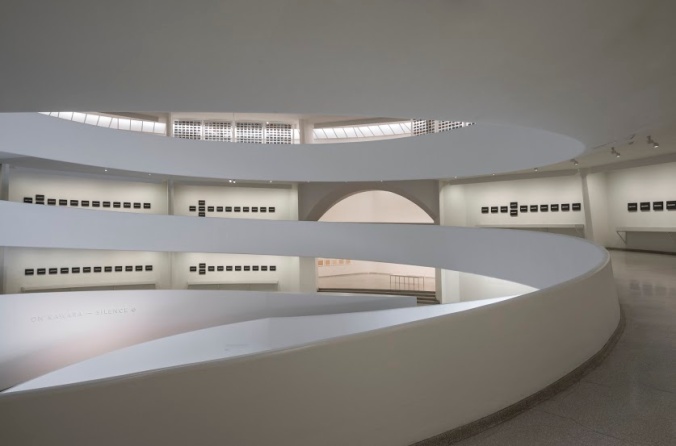Bruce Nauman: Disappearing Acts opened in March at the Schaulager Museum in Basel, Switzerland, to rave critical reviews and social media buzz. Here in New… Continue Reading Master Manipulator: Bruce Nauman at MoMA
Posts tagged as “Conceptual Art”
On April 27, 2015, IFA PhD candidate Anne Wheeler and IFA MA alumna Sarah Zabrodski sat down to discuss the Solomon R. Guggenheim’s current exhibition, On Kawara—Silence. Wheeler is the assistant curator of the exhibition. Zabrodski blogs at emergingartcritic.com.

Sarah Zabrodski: On Kawara proposed most of the exhibition sections and was a close collaborator in the early stages of exhibition planning. What was it like working with the artist?
Anne Wheeler: Senior curator Jeffrey Weiss met On Kawara in 2005, in the process of acquiring the painting Title (1965) for the National Gallery of Art, so he had a relationship with Kawara before approaching him in October 2011 about doing the Guggenheim show. I came onto the project full time in April 2012, and worked for about a year before meeting Kawara himself. We first met almost two years ago to this day, on April 28, 2013—a day I remember clearly—a Sunday. Kawara sent Jeffrey and me a map of a park, with a dot drawn in the location where we were to meet him. We went, and we waited, and finally he came walking toward us, and brought us to a picnic table where we sat and talked with him and other members of his family until the sun went down.
Kawara was very deliberately not a public figure—he was infamous for his refusal to grant interviews, show up for openings, or make public appearances. He told us early on: “I am an artist that never made any public statements,” and we always tried to be extremely respectful and protective of this choice, and of his privacy. Jeffrey took Kawara on a walk-through of the museum early in the process, and we brought him models of the Guggenheim and maquettes of his Date Paintings and other work to help him conceptualize the exhibition within the space without actually having to be there. We always measured what was worth bringing to him, what was worth asking.
Our meetings involved a lot of exhibition planning and talk about the facts of each series—how and when certain artworks were made, or what they were made for—but ultimately the meetings turned out to be more conversational than strictly business. We would go in with questions about, say, where to place a certain Date Painting, but we would end up discussing cave paintings, gravity, the role of art throughout time, the history of human consciousness—really big topics, and his opinions were quite profound. After each meeting, I’d leave thinking, “What was that?”—and then as a researcher, to always have these new “assignments” was such an education for me.
As far as the artwork, though, we never talked about why—“why” questions were not discussed. It’s been one of the funny and difficult things about giving tours, responding to the why questions: “Why these newspapers? Why the red, blue, and gray? Why this or that?” I can say all of the things that I think about the work, but I can never reference anything he actually said.

